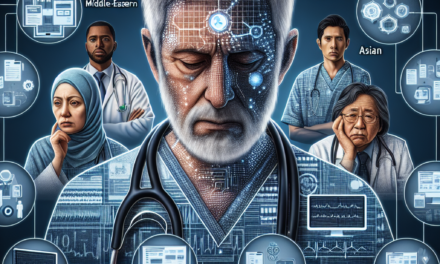Transforming Healthcare: Embracing Digital and Consumer-Friendly Innovations

The healthcare industry is undergoing a significant transformation, driven by the integration of digital technologies and a shift towards consumer-centric models. This evolution is not only enhancing the quality of care but also making healthcare more accessible, efficient, and personalized. In this article, we will explore the various facets of this transformation, examining how digital and consumer-friendly innovations are reshaping the healthcare landscape. We will delve into five key subtopics, each providing a comprehensive analysis of the current trends, challenges, and opportunities in the healthcare sector.
The Rise of Telemedicine: Bridging the Gap in Healthcare Access
Telemedicine has emerged as a pivotal component of modern healthcare, offering a solution to the longstanding issue of access to medical services. By leveraging digital communication technologies, telemedicine enables patients to consult with healthcare providers remotely, breaking down geographical barriers and improving access to care.
Expanding Reach and Accessibility
One of the most significant advantages of telemedicine is its ability to reach underserved populations. Rural areas, in particular, have historically faced challenges in accessing healthcare due to a shortage of medical professionals and facilities. Telemedicine bridges this gap by allowing patients to connect with specialists and receive timely care without the need for long-distance travel.
According to a report by the American Hospital Association, telehealth services have expanded significantly, with over 76% of U.S. hospitals now offering some form of telemedicine. This expansion is not limited to the United States; countries worldwide are adopting telemedicine to improve healthcare access and reduce disparities.
Enhancing Patient Convenience
Telemedicine also enhances patient convenience by reducing the need for in-person visits. Patients can schedule virtual appointments at their convenience, eliminating the need to take time off work or arrange childcare. This flexibility is particularly beneficial for individuals with chronic conditions who require regular monitoring and follow-up care.
Moreover, telemedicine platforms often integrate with electronic health records (EHRs), allowing healthcare providers to access patient information seamlessly. This integration streamlines the consultation process and ensures that patients receive comprehensive and coordinated care.
Challenges and Considerations
Despite its numerous benefits, telemedicine faces several challenges that must be addressed to ensure its widespread adoption and effectiveness. One of the primary concerns is the digital divide, which refers to the gap between individuals who have access to digital technologies and those who do not. To address this issue, policymakers and healthcare organizations must invest in infrastructure and initiatives that promote digital literacy and access to technology.
Additionally, regulatory and reimbursement issues pose challenges to the growth of telemedicine. While many countries have implemented policies to support telehealth, inconsistencies in regulations and reimbursement models can hinder its adoption. Collaborative efforts between governments, healthcare providers, and insurers are essential to create a supportive environment for telemedicine.
Case Study: Telemedicine in Action
A notable example of telemedicine’s impact is the Teladoc Health platform, which provides virtual healthcare services to millions of patients worldwide. Teladoc offers a wide range of services, including primary care, mental health support, and specialist consultations. During the COVID-19 pandemic, Teladoc experienced a surge in demand, highlighting the critical role of telemedicine in maintaining healthcare continuity during crises.
Teladoc’s success demonstrates the potential of telemedicine to transform healthcare delivery and improve patient outcomes. By providing accessible and convenient care, telemedicine is poised to become an integral part of the healthcare ecosystem.
Future Prospects
As telemedicine continues to evolve, its future prospects are promising. Advances in technology, such as artificial intelligence (AI) and machine learning, are expected to enhance telemedicine platforms, enabling more accurate diagnoses and personalized treatment plans. Additionally, the integration of wearable devices and remote monitoring tools will further expand the capabilities of telemedicine, allowing for continuous patient monitoring and proactive healthcare management.
In conclusion, telemedicine is a transformative force in healthcare, offering solutions to longstanding challenges and paving the way for a more accessible and patient-centered healthcare system. By addressing the barriers to adoption and leveraging technological advancements, telemedicine has the potential to revolutionize healthcare delivery and improve patient outcomes on a global scale.
Artificial Intelligence in Healthcare: Revolutionizing Diagnosis and Treatment
Artificial intelligence (AI) is rapidly transforming the healthcare industry, offering innovative solutions to enhance diagnosis, treatment, and patient care. By leveraging advanced algorithms and machine learning, AI is revolutionizing the way healthcare providers approach medical challenges, leading to improved outcomes and efficiencies.
Enhancing Diagnostic Accuracy
One of the most significant contributions of AI in healthcare is its ability to enhance diagnostic accuracy. AI-powered tools can analyze vast amounts of medical data, including imaging scans, lab results, and patient records, to identify patterns and anomalies that may be missed by human clinicians. This capability is particularly valuable in fields such as radiology and pathology, where accurate and timely diagnoses are critical.
For example, AI algorithms have been developed to detect early signs of diseases such as cancer, cardiovascular conditions, and neurological disorders. A study published in Nature Medicine demonstrated that an AI system outperformed human radiologists in detecting breast cancer from mammograms, achieving a higher accuracy rate and reducing false positives.
Personalizing Treatment Plans
AI is also playing a crucial role in personalizing treatment plans for patients. By analyzing individual patient data, including genetic information, lifestyle factors, and medical history, AI can generate tailored treatment recommendations that optimize outcomes and minimize adverse effects. This personalized approach is particularly beneficial in oncology, where treatment responses can vary significantly among patients.
Pharmaceutical companies are leveraging AI to accelerate drug discovery and development. AI algorithms can analyze vast datasets to identify potential drug candidates and predict their efficacy and safety profiles. This approach not only speeds up the drug development process but also reduces costs and increases the likelihood of successful outcomes.
Improving Operational Efficiency
Beyond clinical applications, AI is enhancing operational efficiency within healthcare organizations. AI-powered systems can automate administrative tasks, such as appointment scheduling, billing, and patient triage, freeing up valuable time for healthcare professionals to focus on patient care. Additionally, AI can optimize resource allocation, ensuring that healthcare facilities operate at maximum efficiency.
For instance, AI-driven predictive analytics can forecast patient demand and optimize staffing levels, reducing wait times and improving patient satisfaction. Hospitals are also using AI to manage supply chains, ensuring that essential medical supplies are available when needed and minimizing waste.
Challenges and Ethical Considerations
While AI offers numerous benefits, its integration into healthcare also presents challenges and ethical considerations. One of the primary concerns is data privacy and security. AI systems rely on vast amounts of patient data, raising concerns about data breaches and unauthorized access. Healthcare organizations must implement robust security measures to protect patient information and comply with regulations such as the Health Insurance Portability and Accountability Act (HIPAA).
Another challenge is the potential for bias in AI algorithms. If AI systems are trained on biased datasets, they may produce biased outcomes, leading to disparities in care. To address this issue, developers must ensure that AI algorithms are trained on diverse and representative datasets and regularly audited for fairness and accuracy.
Case Study: AI in Action
A notable example of AI’s impact in healthcare is IBM Watson Health, which uses AI to assist oncologists in developing personalized cancer treatment plans. Watson analyzes patient data and medical literature to provide evidence-based recommendations, helping clinicians make informed decisions. In a study conducted at the University of North Carolina Lineberger Comprehensive Cancer Center, Watson’s recommendations matched those of oncologists in 99% of cases, demonstrating its potential to enhance clinical decision-making.
IBM Watson Health’s success highlights the transformative potential of AI in healthcare, offering a glimpse into a future where AI-driven insights improve patient outcomes and streamline healthcare delivery.
Future Prospects
The future of AI in healthcare is promising, with ongoing advancements expected to further enhance its capabilities. As AI algorithms become more sophisticated, they will be able to analyze increasingly complex datasets, leading to more accurate diagnoses and personalized treatment plans. Additionally, the integration of AI with other technologies, such as the Internet of Things (IoT) and blockchain, will create new opportunities for innovation and collaboration.
In conclusion, AI is revolutionizing healthcare by enhancing diagnostic accuracy, personalizing treatment plans, and improving operational efficiency. While challenges remain, the potential benefits of AI in healthcare are immense, offering a path towards a more efficient, effective, and patient-centered healthcare system.
Wearable Technology: Empowering Patients and Enhancing Health Monitoring
Wearable technology is rapidly gaining traction in the healthcare industry, offering innovative solutions for health monitoring and patient empowerment. These devices, which include smartwatches, fitness trackers, and medical-grade wearables, provide real-time data on various health metrics, enabling individuals to take a proactive approach to their health and well-being.
Real-Time Health Monitoring
One of the primary benefits of wearable technology is its ability to provide real-time health monitoring. Wearable devices can track a wide range of health metrics, including heart rate, physical activity, sleep patterns, and even blood glucose levels. This continuous monitoring allows individuals to gain insights into their health and make informed decisions about their lifestyle and healthcare.
For example, wearable devices equipped with electrocardiogram (ECG) sensors can detect irregular heart rhythms, such as atrial fibrillation, which may go unnoticed without regular monitoring. Early detection of such conditions can lead to timely interventions and improved health outcomes.
Empowering Patients
Wearable technology empowers patients by giving them greater control over their health. By providing access to personalized health data, wearables enable individuals to set health goals, track their progress, and make informed decisions about their lifestyle and treatment options. This empowerment fosters a sense of ownership and responsibility for one’s health, leading to improved adherence to treatment plans and healthier behaviors.
Moreover, wearable devices often integrate with mobile apps and online platforms, allowing users to share their health data with healthcare providers. This connectivity facilitates remote monitoring and enables healthcare professionals to provide personalized feedback and support, enhancing the patient-provider relationship.
Improving Chronic Disease Management
Wearable technology is particularly beneficial for individuals with chronic conditions, such as diabetes, hypertension, and respiratory disorders. These devices enable continuous monitoring of vital signs and health metrics, allowing for early detection of potential complications and timely interventions.
For instance, continuous glucose monitors (CGMs) provide real-time data on blood glucose levels, helping individuals with diabetes manage their condition more effectively. By alerting users to fluctuations in glucose levels, CGMs enable timely adjustments to diet, medication, and physical activity, reducing the risk of complications and improving overall health outcomes.
Challenges and Considerations
Despite the numerous benefits of wearable technology, several challenges must be addressed to ensure its widespread adoption and effectiveness. One of the primary concerns is data privacy and security. Wearable devices collect sensitive health data, raising concerns about data breaches and unauthorized access. Manufacturers and healthcare organizations must implement robust security measures to protect user data and comply with regulations such as the General Data Protection Regulation (GDPR).
Another challenge is the accuracy and reliability of wearable devices. While many wearables provide valuable health insights, their accuracy may vary depending on factors such as device quality, user behavior, and environmental conditions. To address this issue, manufacturers must ensure that wearables undergo rigorous testing and validation to meet medical-grade standards.
Case Study: Wearable Technology in Action
A notable example of wearable technology’s impact is the Apple Watch, which has become a popular tool for health monitoring and fitness tracking. The Apple Watch includes features such as heart rate monitoring, ECG capabilities, and fall detection, providing users with valuable health insights and safety features.
During a study conducted by Stanford University, the Apple Watch’s heart rate monitoring feature was used to detect atrial fibrillation in participants. The study demonstrated the potential of wearable technology to identify undiagnosed heart conditions and facilitate early interventions.
The success of the Apple Watch highlights the transformative potential of wearable technology in healthcare, offering a glimpse into a future where individuals are empowered to take control of their health and well-being.
Future Prospects
The future of wearable technology in healthcare is promising, with ongoing advancements expected to enhance its capabilities and applications. As wearable devices become more sophisticated, they will be able to monitor a wider range of health metrics and provide more accurate and personalized insights. Additionally, the integration of wearables with other technologies, such as AI and IoT, will create new opportunities for innovation and collaboration.
In conclusion, wearable technology is empowering patients and enhancing health monitoring by providing real-time data and personalized insights. While challenges remain, the potential benefits of wearables in healthcare are immense, offering a path towards a more proactive and patient-centered approach to health and well-being.
Blockchain in Healthcare: Securing Data and Enhancing Interoperability
Blockchain technology is emerging as a transformative force in the healthcare industry, offering innovative solutions to enhance data security, interoperability, and transparency. By providing a decentralized and immutable ledger, blockchain has the potential to address some of the most pressing challenges in healthcare data management and exchange.
Enhancing Data Security
One of the primary benefits of blockchain technology is its ability to enhance data security. Healthcare organizations handle vast amounts of sensitive patient data, making them prime targets for cyberattacks and data breaches. Blockchain’s decentralized nature and cryptographic features provide a secure framework for storing and sharing data, reducing the risk of unauthorized access and tampering.
In a blockchain network, data is stored in blocks that are linked together in a chronological chain. Each block contains a cryptographic hash of the previous block, ensuring that any attempt to alter the data would require consensus from the entire network. This immutability makes blockchain an ideal solution for protecting patient data and maintaining data integrity.
Improving Interoperability
Blockchain technology also has the potential to improve interoperability in healthcare, addressing the longstanding issue of fragmented data systems. Healthcare providers often use disparate electronic health record (EHR) systems that are not easily compatible, leading to inefficiencies and data silos. Blockchain can facilitate seamless data exchange by providing a standardized and interoperable platform for sharing patient information.
By enabling secure and transparent data sharing, blockchain can improve care coordination and ensure that healthcare providers have access to comprehensive and up-to-date patient information. This interoperability is particularly valuable in emergency situations, where timely access to patient data can be critical for making informed treatment decisions.
Enhancing Transparency and Trust
Blockchain’s transparent and tamper-proof nature can enhance trust and accountability in healthcare transactions. By providing a verifiable record of all data exchanges and transactions, blockchain can reduce fraud and ensure that all parties involved in a healthcare transaction are held accountable.
For example, blockchain can be used to track the supply chain of pharmaceuticals, ensuring that medications are authentic and have not been tampered with during distribution. This transparency can help combat counterfeit drugs and ensure that patients receive safe and effective treatments.
Challenges and Considerations
Despite its potential benefits, the integration of blockchain technology into healthcare also presents challenges and considerations. One of the primary challenges is scalability. Blockchain networks can become slow and inefficient as the number of transactions increases, posing challenges for large-scale healthcare applications. To address this issue, developers are exploring solutions such as sharding and off-chain transactions to improve scalability.
Another challenge is regulatory compliance. Healthcare organizations must ensure that blockchain implementations comply with regulations such as HIPAA and GDPR, which govern data privacy and security. This compliance requires careful consideration of how blockchain networks are designed and managed.
Case Study: Blockchain in Action
A notable example of blockchain’s impact in healthcare is the MediLedger Project, which aims to enhance the pharmaceutical supply chain using blockchain technology. The project involves collaboration between pharmaceutical companies, distributors, and technology providers to create a secure and transparent platform for tracking medications from manufacturer to patient.
The MediLedger Project has demonstrated the potential of blockchain to improve supply chain efficiency, reduce fraud, and enhance patient safety. By providing a verifiable record of each transaction, the project ensures that medications are authentic and have not been tampered with during distribution.
Future Prospects
The future of blockchain in healthcare is promising, with ongoing advancements expected to enhance its capabilities and applications. As blockchain technology continues to evolve, it will become more scalable and efficient, enabling its integration into a wider range of healthcare applications. Additionally, the combination of blockchain with other technologies, such as AI and IoT, will create new opportunities for innovation and collaboration.
In conclusion, blockchain technology is transforming healthcare by enhancing data security, interoperability, and transparency. While challenges remain, the potential benefits of blockchain in healthcare are immense, offering a path towards a more secure, efficient, and patient-centered healthcare system.
Patient-Centric Care: Redefining the Healthcare Experience
The shift towards patient-centric care is redefining the healthcare experience, placing patients at the center of their care journey. This approach emphasizes personalized care, shared decision-making, and improved communication between patients and healthcare providers. By focusing on the needs and preferences of patients, patient-centric care aims to enhance patient satisfaction, engagement, and outcomes.
Personalized Care
Personalized care is a cornerstone of patient-centric care, recognizing that each patient is unique and requires individualized treatment plans. By considering factors such as genetics, lifestyle, and preferences, healthcare providers can tailor interventions to meet the specific needs of each patient.
Advancements in genomics and precision medicine are driving the personalization of care, enabling healthcare providers to develop targeted therapies based on a patient’s genetic profile. This approach not only improves treatment efficacy but also reduces the risk of adverse effects, leading to better patient outcomes.
Shared Decision-Making
Shared decision-making is another key component of patient-centric care, emphasizing collaboration between patients and healthcare providers. This approach involves open communication and active participation from patients in their care decisions, ensuring that their values and preferences are considered.
By involving patients in the decision-making process, healthcare providers can build trust and foster a sense of ownership over their care. This collaboration leads to improved adherence to treatment plans and greater patient satisfaction.
Improving Communication
Effective communication is essential for delivering patient-centric care. Healthcare providers must ensure that patients have access to clear and accurate information about their condition, treatment options, and potential outcomes. This transparency empowers patients to make informed decisions and actively participate in their care.
Technology plays a crucial role in enhancing communication between patients and healthcare providers. Patient portals, telehealth platforms, and mobile apps provide convenient channels for communication, enabling patients to access information, schedule appointments, and communicate with their care team from anywhere.
Challenges and Considerations
While patient-centric care offers numerous benefits, its implementation also presents challenges and considerations. One of the primary challenges is ensuring that healthcare providers have the time and resources to deliver personalized care. The demands of a busy clinical environment can make it difficult for providers to engage in meaningful conversations with patients and develop individualized treatment plans.
Another challenge is addressing health disparities and ensuring that all patients have access to patient-centric care. Healthcare organizations must implement strategies to address social determinants of health and ensure that underserved populations receive equitable care.
Case Study: Patient-Centric Care in Action
A notable example of patient-centric care is the Cleveland Clinic’s “Patient First” initiative, which focuses on delivering personalized and compassionate care to patients. The initiative emphasizes open communication, shared decision-making, and a commitment to understanding each patient’s unique needs and preferences.
The Cleveland Clinic’s success in implementing patient-centric care has led to improved patient satisfaction scores and better health outcomes. By prioritizing the needs of patients, the clinic has set a standard for delivering high-quality, patient-centered care.
Future Prospects
The future of patient-centric care is promising, with ongoing advancements expected to enhance its implementation and impact. As technology continues to evolve, healthcare providers will have access to new tools and resources for delivering personalized care and improving communication with patients. Additionally, the integration of patient-centric care with other innovations, such as AI and telemedicine, will create new opportunities for enhancing the patient experience.
In conclusion, patient-centric care is redefining the healthcare experience by placing patients at the center of their care journey. By focusing on personalized care, shared decision-making, and improved communication, patient-centric care aims to enhance patient satisfaction, engagement, and outcomes. While challenges remain, the potential benefits of patient-centric care are immense, offering a path towards a more compassionate and effective healthcare system.
Conclusion
The transformation of healthcare through digital and consumer-friendly innovations is reshaping the industry, offering new opportunities for improving access, efficiency, and patient outcomes. Telemedicine is bridging the gap in healthcare access, while artificial intelligence is revolutionizing diagnosis and treatment. Wearable technology is empowering patients and enhancing health monitoring, and blockchain is securing data and enhancing interoperability. Patient-centric care is redefining the healthcare experience by placing patients at the center of their care journey.
While challenges remain, the potential benefits of these innovations are immense, offering a path towards a more accessible, efficient, and patient-centered healthcare system. By embracing digital technologies and consumer-friendly models, healthcare organizations can enhance the quality of care and improve patient outcomes on a global scale. As the healthcare industry continues to evolve, these innovations will play a critical role in shaping the future of healthcare delivery.





